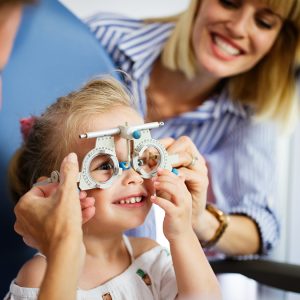At what age does a child have 20/20 vision?
Do all children have perfect vision? If so, when do their eyes reach full maturity? These are some of the questions we hear from parents before their child’s first pediatric optometrist appointment. Read on to learn about 20/20 vision and optical development in children.

What is 20/20 vision?
20/20 vision means that at 20 feet away, you can clearly see objects 20 feet away from you. A higher second number indicates vision impairment. In the case of 20/40 vision, you have to stand 20 feet away to see something others can clearly see at 40 feet away.
Twenty feet is the reference distance for vision because that’s when eyes are relaxed and comfortable.
Average age child develops 20/20 vision
Most children will develop 20/20 vision by the time they reach 2-3 years old. Some children experience delays in vision development, and others never develop 20/20 vision. Children may experience vision problems around 6-12 years old. This is the average age children get their first corrective lenses if needed.
Child vision milestones: What to watch for at each age
If you’re not sure what your child’s vision progression should look like, here are some milestones to watch out for:
- 0-3 months: Should be able to follow an object with their eyes
- 5-7 months: Develops full-color vision and turns head to look at objects
- 12-18 months: Develops depth perception, walks toward objects of interest, and recognizes themself in the mirror
- 2-3 years: Most children have 20/20 vision around this time
- 4-6 years: Begins reading and feels comfortable seeing at different distances
- 6+ years: Signs of vision impairment may start to occur, such as squinting or standing close to the TV
How to prevent and address childhood vision impairment
If you suspect your child may have vision problems, see an eye doctor as soon as possible. Early intervention is always ideal. Children can start seeing a pediatric optometrist at any age, but most start around the time they enter school. If there are no vision issues, your child should only need checkups every 2-3 years. If your child has vision impairment, plan for yearly checkups.
